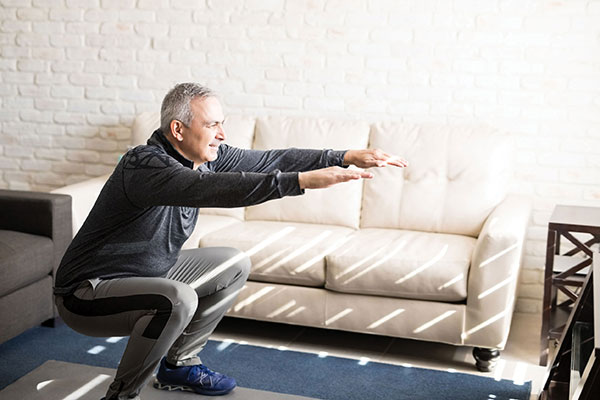A Prescription for Exercise
Fundamental Physical Fitness Guidelines for Cancer Survivors
by Nancy Campbell, MS
The vital role exercise plays in cancer care is becoming more evident every day. Nearly a decade ago, the American College of Sports Medicine published guidelines on exercise for cancer survivors, recommending for the first time that all cancer survivors strive to avoid inactivity. In October 2019, the ACSM updated their guidelines, citing new research linking physical activity with numerous health benefits, including reduced risk for multiple types of cancer and improved survival and quality of life among cancer survivors. The new guidelines even go as far as to recommend that physicians should provide exercise prescriptions for anyone living with and beyond cancer.
According to the latest research, not only is exercise generally safe and well-tolerated by cancer survivors, but it also has been shown to improve survivors’ physical functioning, reduce anxiety and depressive symptoms, and lessen fatigue during and after cancer treatments. While your doctor is the only one who can make exercise recommendations specific to you, here are some general exercise guidelines that most cancer survivors can follow.
• Start slow.
Before you start exercising, you should check in with your medical team to make sure they don’t have any concerns. Once they have given you clearance, it is important to start slowly. As you are beginning to establish a physical fitness routine, set yourself up for success by finishing each exercise session knowing you could have done a little bit more. You want to make sure your activity is enjoyable, not exhausting.
You don’t even need to join a gym or own a set of dumbbells. Strength-training exercises like squats, wall pushups, and abdominal crunches can be done at home using your own body weight.
Fatigue is one of the most common and frustrating side effects of cancer treatment. Though it may seem counter-intuitive, exercise is one of the best ways to boost your energy. Even a short walk around your house or to the end of the driveway and back can help take the edge off cancer-related fatigue. As you get stronger, try building up to two or three 10-minute bursts of physical activity over the course of the day.
And don’t forget about strength training. Scientists have long known that resistance exercises (like pushups and weightlifting) can help cancer survivors maintain bone and muscle mass, as well as a healthy weight. But recent research has shown that this type of exercise may also lower your risk of cancer recurrence. For example, a recent study found that the more muscle mass colon cancer survivors have, the lower their risk of cancer recurrence. While this area of research is still evolving, if the data holds, that just gives you one more reason to start strength training. You don’t even need to join a gym or own a set of dumbbells. Strength-training exercises like squats, wall pushups, and abdominal crunches can be done at home using your own body weight.
• Set S.M.A.R.T. goals and track your progress.
Many cancer survivors find it useful to set a daily or weekly exercise goal to keep them on track. Just make sure that your goal is S.M.A.R.T.:
• Specific
• Measurable
• Attainable
• Relevant
• Time-bound
For example, instead of saying, “I’m going to exercise more,” try setting a more concrete goal. For example, “I will walk for 15 minutes on Monday, Wednesday, and Friday mornings.” Setting small goals like this can help keep you moving forward, as you are focusing on making one small change at a time in order to reach your overall wellness goals.
Look for creative ways to add more movement into your daily routine while also decreasing the amount of time that you are sedentary.
There are so many ways to keep track of your exercise progress. Maybe it’s a calendar on your refrigerator or a wearable activity tracker, like Fitbit. The main goal of fitness tracking is to let you know how much activity you are getting and remind you to keep it up.
In the beginning, it’s best to focus on being consistent with your exercise routine rather than worrying about the duration or intensity of your workout. This will help your body gradually adjust to incorporating more physical activity into your lifestyle. As your body is recovering from treatment, you want to avoid doing long or intense stretches of physical activity that leave you exhausted and unable to exercise again a day or two later. Remember, start slow.
Exercise should also be more than a single event in your day. The goal is to stay as active as possible throughout the day. Look for creative ways to add more movement into your daily routine while also decreasing the amount of time that you are sedentary. Many activity trackers will alert you when you have been inactive for more than an hour. You can also set a reminder on your phone or computer that signals you to get up every hour and move. Another strategy is to park farther away when you are running errands, or get off the bus one stop earlier and walk that extra block.
• Seek out resources.
Many different programs are available to help cancer survivors stay active. For example, YMCAs across the country offer a program called LIVESTRONG at the YMCA, which is specifically designed for cancer survivors. Through the program, cancer survivors take part in free or low-cost customized exercise routines created by certified fitness instructors and tailored to each survivor’s individual needs.
In addition, many hospitals and wellness centers offer movement classes for cancer survivors. Check with your healthcare team to see if one is available in your area. If you are struggling with side effects from treatment, like neuropathy, that make it difficult to exercise, a physical therapist, occupational therapist, or cancer exercise specialist can help customize an exercise program to meet your unique needs.
Finally, be kind to your body as you are recovering from treatment and easing into an exercise routine. It may be slow going at first, but that’s OK. I always say, 10 percent of something is better than 100 percent of nothing.

Nancy Campbell is an exercise physiologist who offers fitness consults and classes to cancer survivors through Dana-Farber Cancer Institute’s Zakim Center for Integrative Therapies and Healthy Living in Boston, MA. Learn more at Dana-Farber.org/exercise.
Many hospitals are currently researching the effects of exercise on cancer survivors and may have clinical trials that you could be eligible for. These can be a great tool to help you get active or stay motivated as you pursue physical activity. You can find these trials by visiting Dana-Farber.org/exercise and entering “exercise and cancer” in the search box.
This article was published in Coping® with Cancer magazine, January/February 2020.


